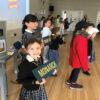
by Iona Naylon
Kids’ Yoga with Iona
The benefits of yoga for children are wide reaching and long lasting. The foundations of physical practise, breathing techniques, meditation and yogic philosophy can be introduced in a fun way from a very young age and can provide solid ground for the healthy, happy development of individuals throughout childhood, into adolescence and beyond. When experienced with a grown-up, yoga can help strengthen emotional bonds and deepen the relationship you have with your little one.
Asana – physical practise
At the most basic level, it’s exercise! Moving your body, making shapes and exploring your physical capacity. Children can have immense fun with the physical aspect of yoga; mimicking things found in nature and exploring how to express feelings and moods with their bodies. From tree pose and dog pose, to happy baby and more. Physical practise can be immensely liberating for children and their grown-ups. Moreover, when poses are practiced together (partner yoga), asana practise not only becomes more fun, but trust is enhanced and loving relationships greatly enriched.
Pranayama – breathing practise
The breath is the backbone of all yogic practise. By teaching children belly breathing from a young age, we can equip them with a vital tool to take charge of their own emotions. Belly breathing, or diaphragmatic breathing, allows our body to tune into its parasympathetic nervous system; our natural rest and digest response (the antithesis of the fight or flight stress response), that allows physical and emotional reactions to calm down. When paired with a visualisation, such as a spiky monster in their tummy that can be breathed into a fluffy kitten, children can really grab hold of and run with this. Pranayama allows children a space to explore feelings they might not be able to articulate, but can take charge of, with self-awareness, by simply putting their hands on their tummy and breathing.
Sankalpa – intention setting
A sankalpa is a positive statement in the present tense. It may not be something that is true right now, but is something that the heart desires. A sankalpa can be very powerful for adults as well as children. Some examples are: I am brave, I am loved, I am good enough, I am strong inside and out, I am calm and peaceful. A sankalpa can be used like a personal mantra to foster those feelings your child really wants to feel, and to squash self-doubt. A sankalpa is a great tool for growing confidence in a shy or anxious child, as well as building long-lasting emotional resilience and inner strength in all children.
Mudra and Mantra – hand seals and chanting
Children love exploring mudra and mantra, and these two make a perfect pair. Making shapes with their hands and singing in a strange language is not only fun, but also quite mystical and wondrous. When sat on their grown-up’s lap, children can feel the vibrations of the mantra resonating in their own body and this can be very comforting; akin to being back in the womb.
Shavasana – lying still
Most children can wrap their feet around their head and touch their toes without any effort. Lying still in shavasana is the most difficult thing any yoga teacher can ask them to do. However, even a minute lying in shavasana at the end of a yoga session is immensely valuable. Shavasana helps the body and mind totally relax. It allows the effects of the yoga practise to settle, and it allows the child time to reconnect with their belly breathing. With slightly older children, it is a good opportunity to introduce more sophisticated yogic practices: rotation of consciousness (relaxing individual body parts), visualisation, pratyahara (sense withdrawal, where you are aware of but not distracted by your senses: sounds, physical feelings etc). I find it immensely interesting to watch children grow used to lying in shavasana. It is a real skill. For some, it strikes a chord quite quickly. For others, it may take some time. But when, as a teacher, I see children week-by-week becoming more comfortable in shavasana, then I know that their yogic practise is really sinking in. And that is the best feeling.
For further details please see www.facebook.com/kidsyogawithiona or email iona.yogaga@gmail.com










